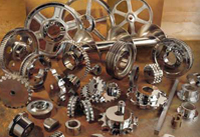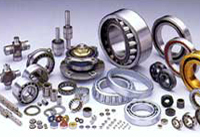 Conveyor systems have been an integral tool for many businesses for over a decade. They operate effectively thanks to an array of different components that work together in unison. Conveyor systems are used in many different industries and can be used to move everything from small machinery parts to massive stones in quarries. And, while conveyors are commonly used in industrial settings, they are also used in virtually every grocery store, for moving sidewalks, baggage handling systems, escalators, and elevators. There are many different types of conveyor systems and each different type of system has unique components depending on the size and type of the system and what type of material is being transported on the conveyor system. Every conveyor system uses pulleys as part of the machinery to move and function. But, just like there are many different types of conveyor systems, there are also different types of conveyor pulleys. Below we explore 4 different types of conveyor pulleys and how they differ from each other.
Conveyor systems have been an integral tool for many businesses for over a decade. They operate effectively thanks to an array of different components that work together in unison. Conveyor systems are used in many different industries and can be used to move everything from small machinery parts to massive stones in quarries. And, while conveyors are commonly used in industrial settings, they are also used in virtually every grocery store, for moving sidewalks, baggage handling systems, escalators, and elevators. There are many different types of conveyor systems and each different type of system has unique components depending on the size and type of the system and what type of material is being transported on the conveyor system. Every conveyor system uses pulleys as part of the machinery to move and function. But, just like there are many different types of conveyor systems, there are also different types of conveyor pulleys. Below we explore 4 different types of conveyor pulleys and how they differ from each other.
4 Types of Conveyor Pulleys
- Drum Pulleys
- Drum pulleys typically do not have grooves and provide continuous belt contact and are available in a variety of diameters. Many drum pulleys are grooved to reduce slippage and improve traction. Some drum pulleys are also tapered.
- Wing Pulleys
- Wing pulleys are very popular because they are self-cleaning. The wings help naturally move material buildup to the side of the conveyor. Because of the self-cleaning nature of wing pulleys traction is improved which means they operate very efficiently. There are a variety of wing pulleys including heavy-duty wing pulleys, spiral wing pulleys, herringbone wing pulleys, and more.
- Lagged Pulleys
- Conveyor pulley lagging is an important part of any conveyor system where improved friction grip is needed. This can be needed due to things like dampness or poor drive ratios (for example: elevator belts). The conveyor pulleys are ‘lagged’ with rubber to reduce slipping and wear. There are different lagging patterns depending on specific needs.
- Motorized Pulleys
- Internally motorized conveyor pulleys save space and improve the efficiency of conveyor operation. By using motorized pulleys you keep your conveyor system as compact and durable as possible. Motorized pulleys are also far safer than traditional hydraulic conveyor systems.


















